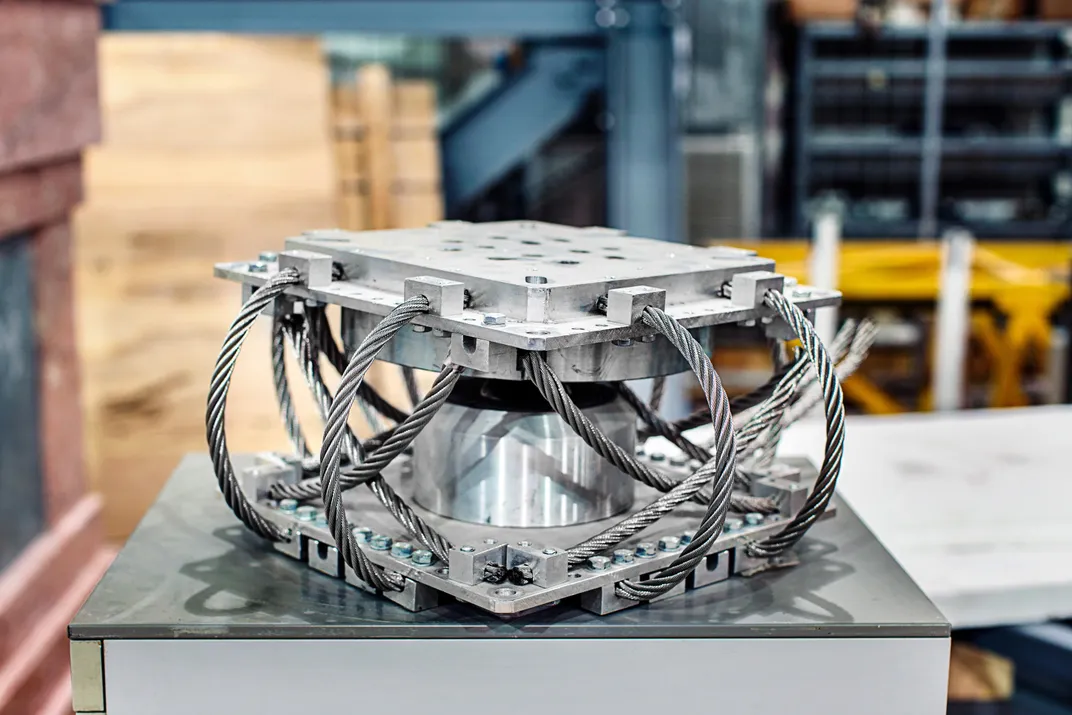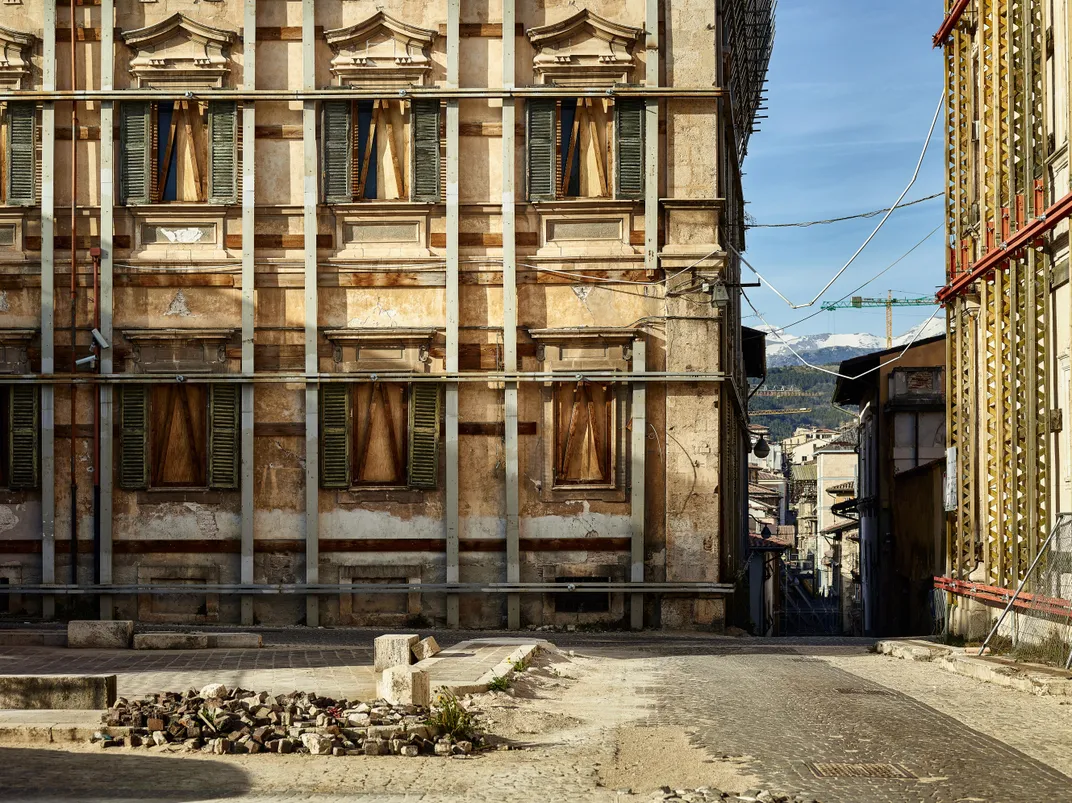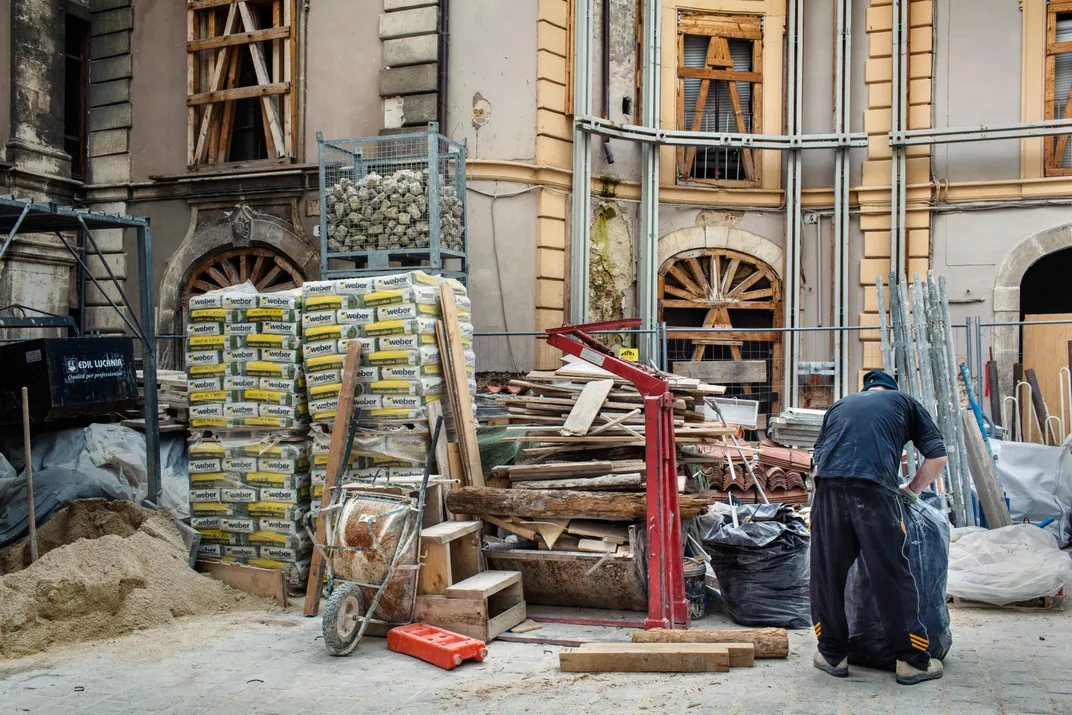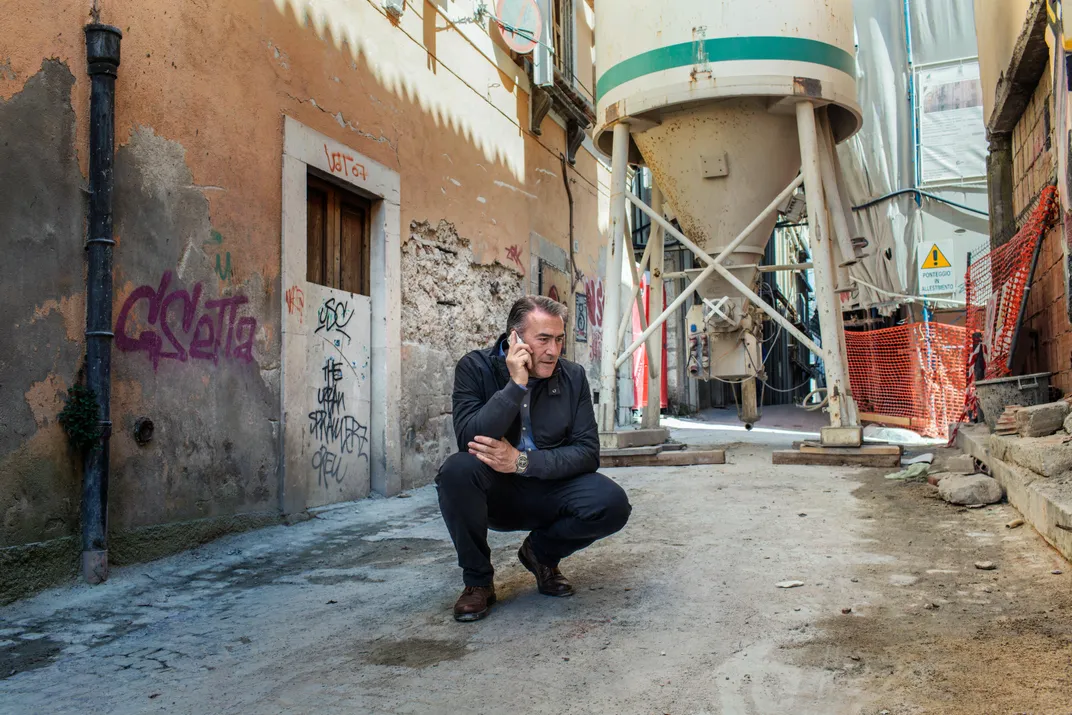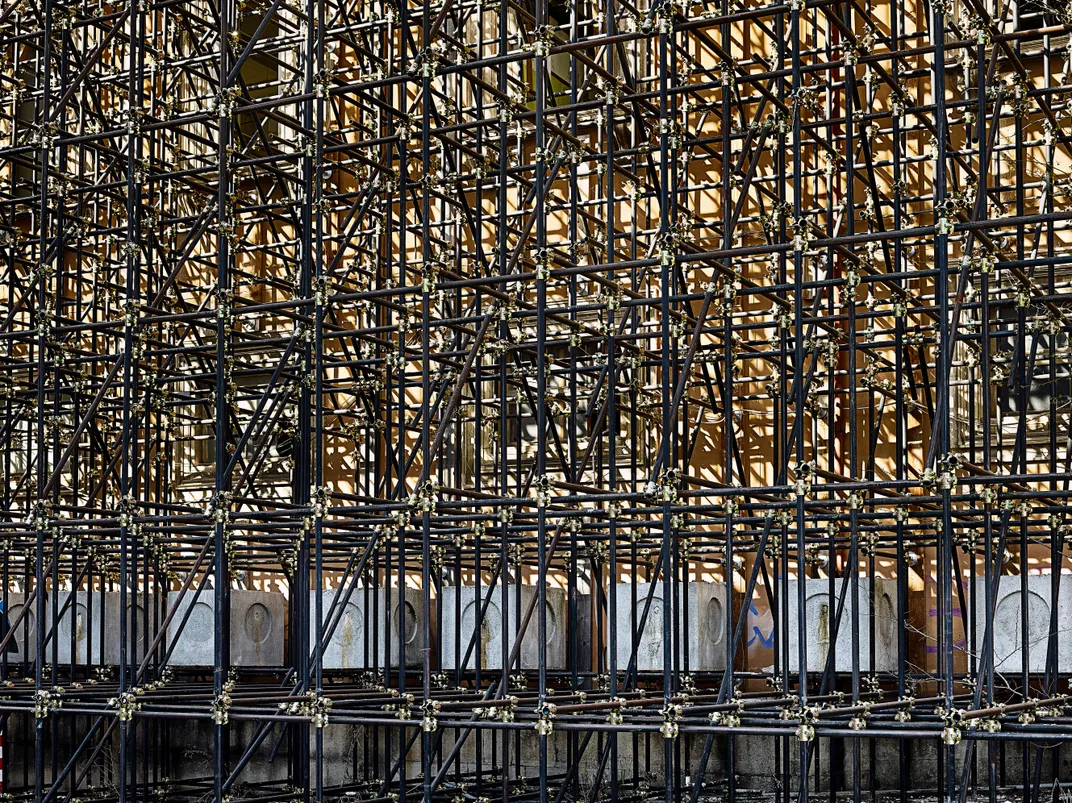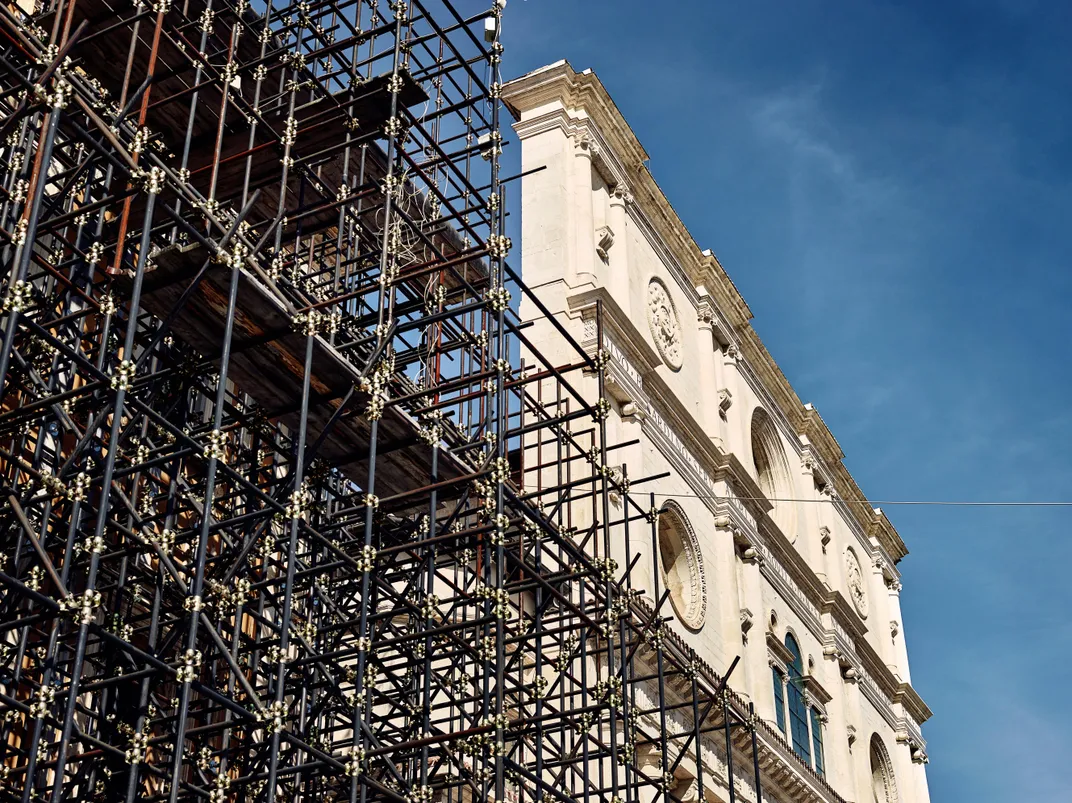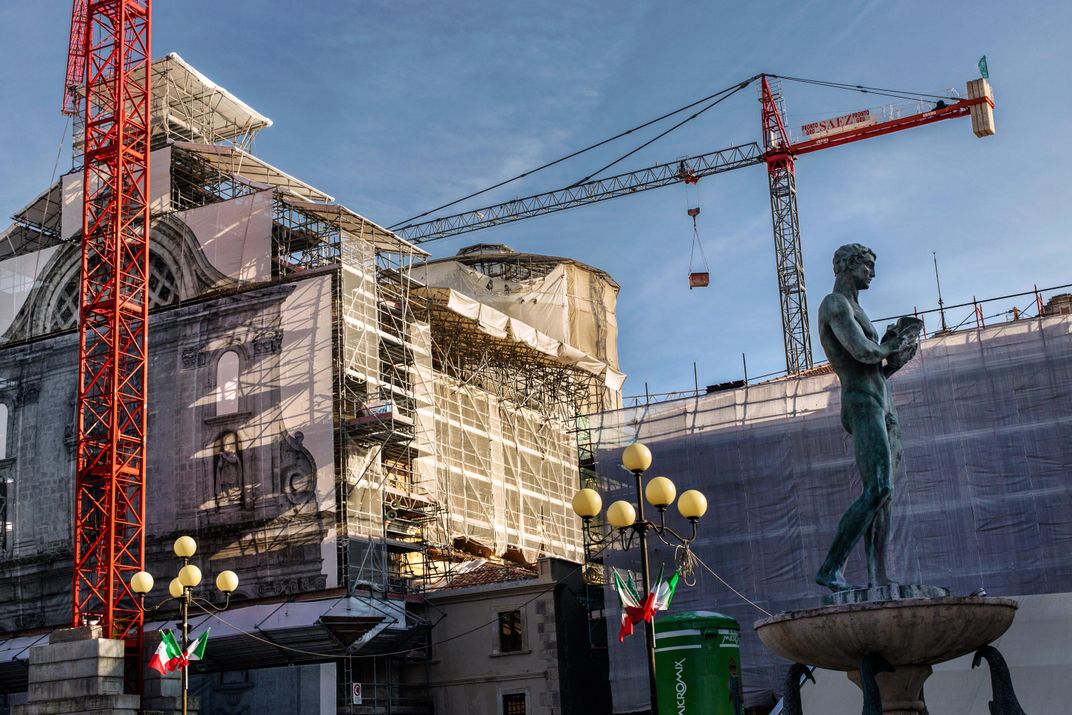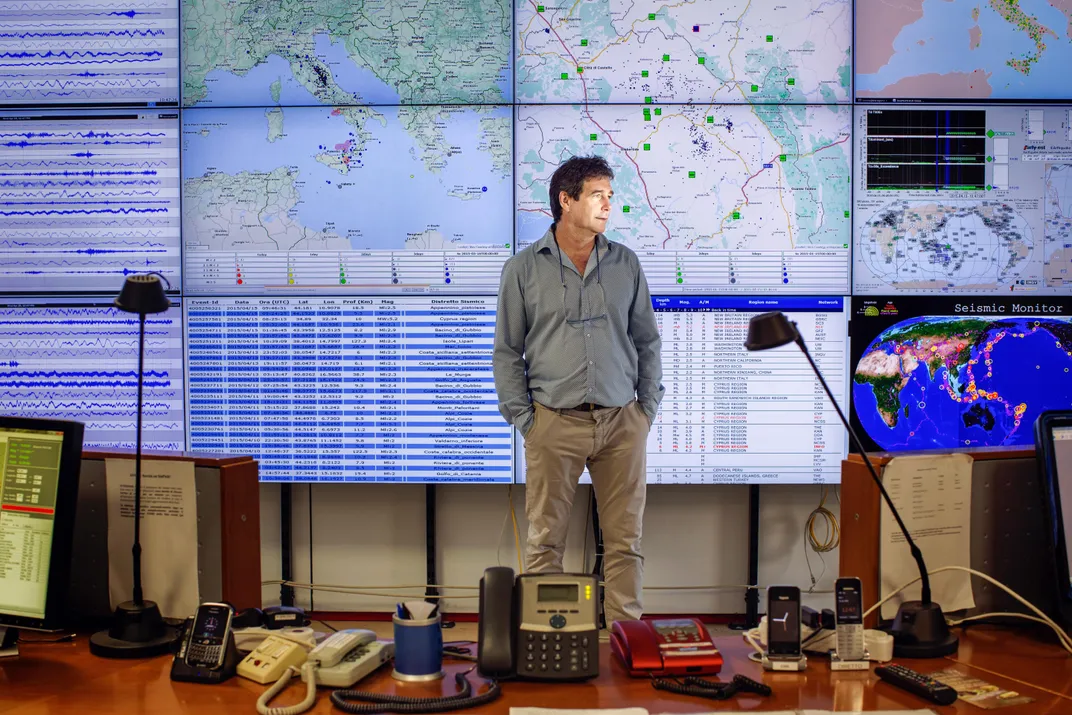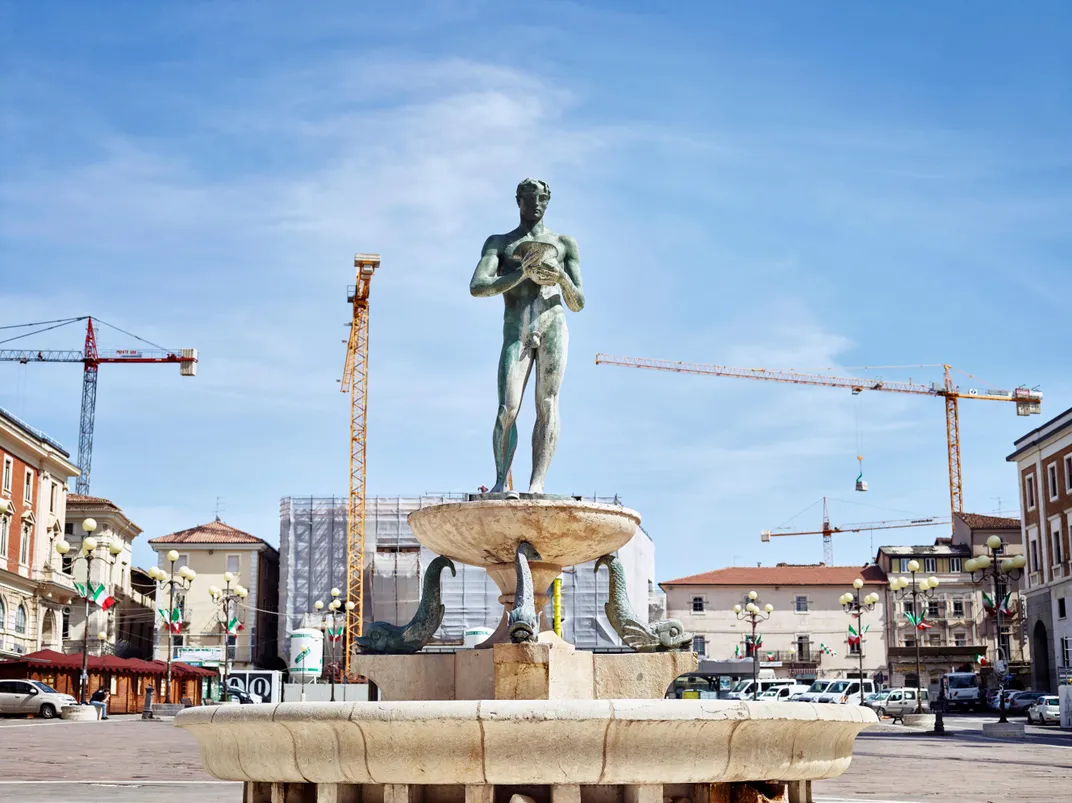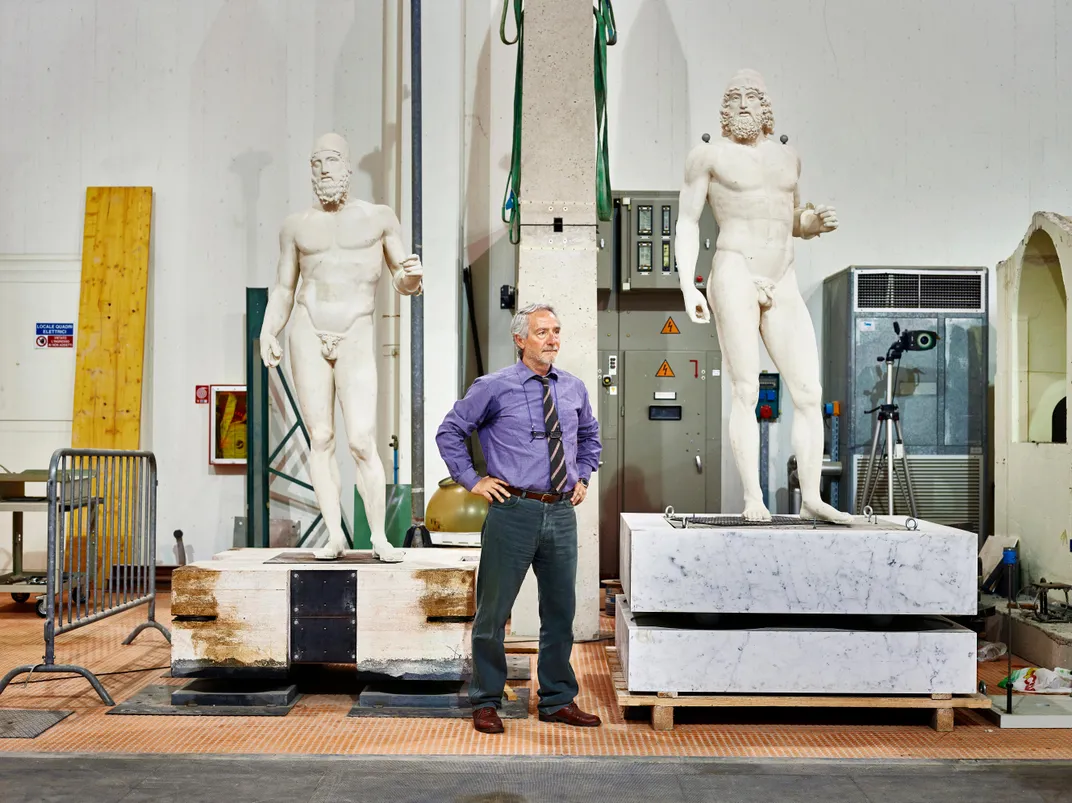The Shaky Science Behind Predicting Earthquakes
A powerful earthquake in Italy killed hundreds of people—and set in motion a legal battle and scientific debate that has kept seismologists on edge
/https://tf-cmsv2-smithsonianmag-media.s3.amazonaws.com/filer/d1/da/d1da393f-63ac-4dca-a833-6869e8f11918/jun2015_l03_seismologists.jpg)
It’s a typical day and Italy is shaking.
I am standing in the monitoring room at the National Institute of Geophysics and Volcanology, in Rome, and I watch the earthquakes taking place in real time. At least two people staff the room 24 hours a day, 365 days a year. The quakes—terremoti, or earth motions, as they say in Rome—pop up as red, yellow and black dots on a series of screens that cover the front wall. When I arrive, just before noon, there have already been four quakes of a magnitude greater than 2.0 recorded that morning in Italy. There have also been 16 smaller quakes. Most of these have been concentrated in an area northwest of Florence, which is experiencing what’s known as an earthquake “swarm.” By the time I leave the room, an hour or so later, two more terremoti have jolted the area.
“It’s a quiet day,” Giulio Selvaggi, a seismologist at the institute, tells me. Selvaggi is a trim man with dark hair, light eyes and a dry wit. “For the moment,” he adds.
Thanks to the northward drift of Africa, the “boot” of Italy is gradually being compressed, like a leg being pushed from below. Meanwhile, for reasons no one entirely understands, the country is also expanding laterally, like a thigh growing wider. The net result is that Italy is known, perhaps euphemistically, as “seismically active.” Small earthquakes happen all the time; every decade or so, there’s a major one. (Repeated quakes are one of the main reasons ancient Rome now lies in ruins.) A sequence of quakes in Assisi in 1997 killed at least ten people and destroyed a series of world-renowned frescoes in the Basilica of San Francesco. In 2002, twenty-seven schoolchildren died in the southern region of Molise when a quake destroyed the roof of their school. Today, whenever there’s an earthquake in Italy of a magnitude greater than 2.5, one of the technicians in the monitoring room in Rome picks up a red phone and reports it to the country’s Department of Civil Protection. This way, the department can explain to nervous citizens why their pictures have dropped from the walls or their dishes have rattled. What would be a lot more useful, of course, would be a system that alerts residents minutes, hours or better still days in advance of a quake. People could then take real precautions. They could secure artworks and other valuables. They could fasten down their furniture and evacuate their homes.
The most recent major earthquake struck in April 2009, in the mountainous region of Abruzzo. More than 300 people were killed, thousands were left homeless and the picturesque center of the region’s capital, L’Aquila, was left in ruins. Outside the region, the L’Aquila earthquake is famous not so much for the devastation that it caused as for the legal battle that ensued, one that essentially put the science of earthquake prediction on trial.
**********
The city of L’Aquila sits about an hour and a half northeast of Rome, on a hilltop shadowed by some of the highest peaks of the Apennines. The mountain chain, which runs down the center of Italy’s leg, like the seam of a stocking, is among the country’s most seismically dangerous areas, and it has a long history of tragedy. In 1461, a quake largely destroyed L’Aquila; this happened again in 1703. A magnitude 6.9 quake centered in the nearby town of Avezzano killed more than 30,000 people in 1915. The L’Aquila quake six years ago had a magnitude of 6.3 and, because its center was close to the surface of the earth, it was unusually destructive.
The drama of the 2009 earthquake began in the fall of 2008, when L’Aquila experienced a seismic swarm. Dozens of tremors shook the city, most too minor to be felt. The swarm continued through the early months of 2009, and some of the tremors were powerful enough to prompt school evacuations. People began to worry that the shaking was a sign that a disaster was imminent. Their anxieties were heightened by an amateur seismologist named Giampaolo Giuliani, who claimed he could predict quakes on the basis of radon levels. (Radon, a colorless, odorless radioactive gas, is present in small quantities in most rock formations.) Giuliani had installed radon detectors around L’Aquila and reported seeing levels rise sharply, which, by his account, represented a dire warning.
To address the mounting sense of panic, Italy’s National Commission for Forecasting and Preventing Great Risks held a special meeting in L’Aquila. The seismologists present pointed out what was known: L’Aquila was in a high-risk area. Seismic swarms only rarely precede major quakes. Meanwhile, studies had shown that radon spikes had no forecasting value.
A week after the commission met, on April 6, at 3:32 a.m., the quake struck. It lasted only 20 seconds, but the damage was enormous. Survivors described a roaring sound, a hideous shaking and a cascade of debris. “It was like being in a blender,” a L’Aquila resident who lost his wife and daughter in an apartment building collapse would later tell the journal Nature.
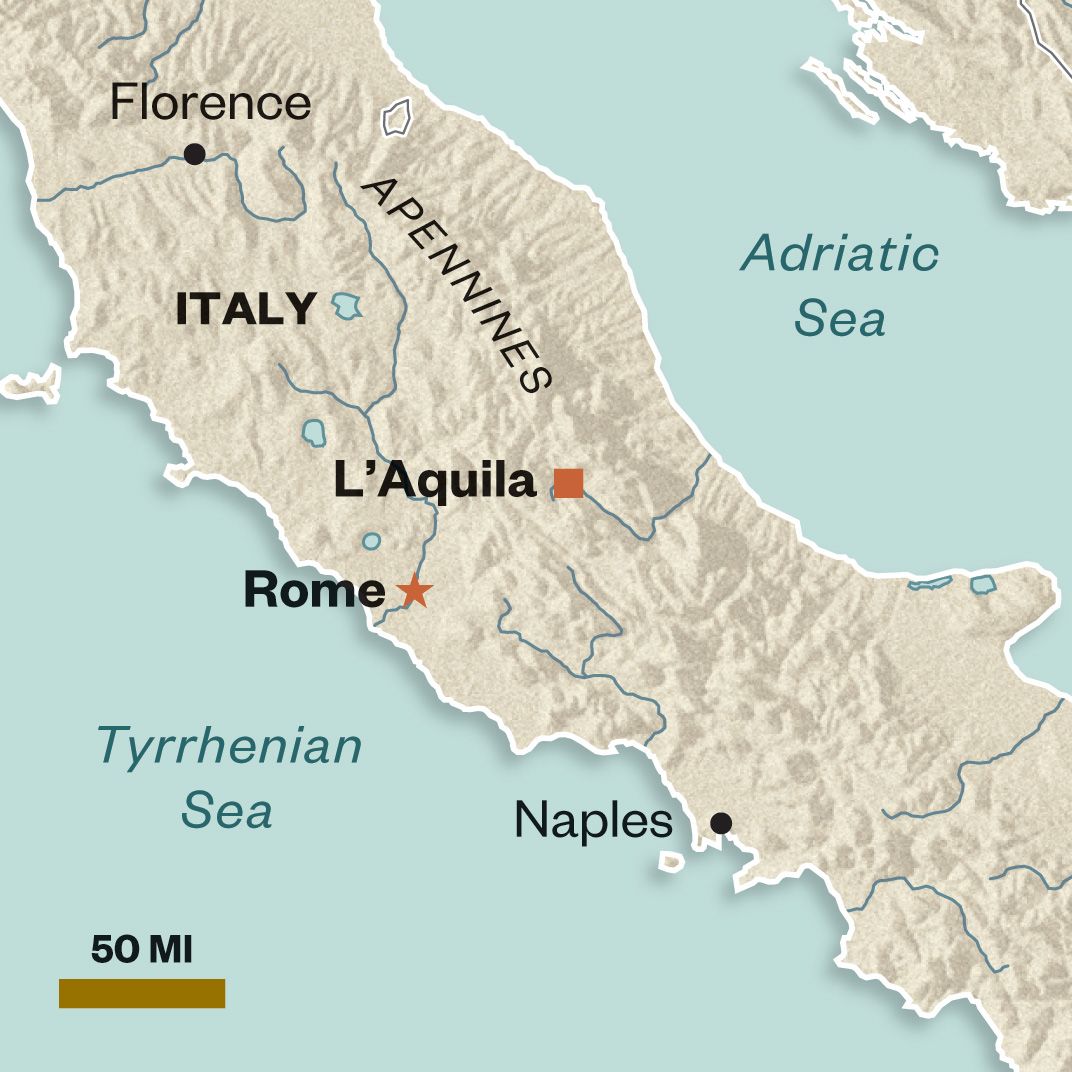
Grief turned quickly to outrage. How could the experts have failed so badly? One government official from the National Department of Civil Protection had gone so far as to state before the quake that the seismic swarm in L’Aquila had reduced the danger of a major event, a claim based on a misunderstanding of the underlying science. Some residents said this statement had convinced them to stay inside on the night of the quake and that this, in turn, had cost family members their lives.
In 2010, six of the scientists who’d participated in the meeting in L’Aquila were charged with manslaughter, along with the government official. One of the scientists was Giulio Selvaggi, then director of the National Institute of Geophysics and Volcanology. “I couldn’t believe it,” Selvaggi told me of the indictment. “I thought it was a mistake.”
The prosecutors in the case argued that, while there might be no way of reliably predicting earthquakes, the scientists were nevertheless criminally negligent, as they’d failed to adequately assess the risk of a quake. To the defendants, this was a distinction without a difference.
“An earthquake is unpredictable, so the risk is unpredictable,” Selvaggi said to me. Scientists all around the world—indeed, scientists across fields—condemned the case as a witch hunt tricked out with statistics.
“The charges against these scientists are both unfair and naive,” the head of the American Association for the Advancement of Science, Alan Leshner, wrote in an open letter to the Italian president. The American Geophysical Union warned that the case could have a dangerous rebound effect, discouraging scientists “from advising their government or even working in the field of seismology” because of the legal risks.
The trial, which was held in L’Aquila, lasted more than a year. All those charged were found guilty. Prosecutors had recommended four-year prison terms; the judge handed down sentences of six years. The defendants’ guilt, he explained, was “severe.” One of those convicted, Claudio Eva, a seismologist from the University of Genoa, called the decision “very Italian and medieval.”
The appeal of the L’Aquila verdict took another two years. At its conclusion, the six scientists were all acquitted, though for the seventh defendant—the government official—the verdict was upheld. At the time I visited Selvaggi, his conviction had just recently been overturned, and he still seemed deeply shaken by the experience. He felt confident that he’d done nothing wrong, but he found the wrath of the victims’ families difficult to bear. Meanwhile, his teenage children had a tough time dealing with the negative publicity surrounding the trial. “It was terrible,” he said. Alessandro Amato, one of Selvaggi’s colleagues at the institute, told me that the damage to the reputations of the scientists will be hard to undo. “The second verdict stated that the scientists were not responsible legally,” he said. (Amato, who was not involved in the case, is now working on a book about it.) “But most people still think they are. So many people think we are hiding from our responsibilities, that earthquakes are somehow predictable, but we just don’t want to admit it.”
**********
Not long after I visited the Institute of Geophysics and Volcanology, I took a bus from Rome to L’Aquila. A geologist at the institute named Fabrizio Galadini, who works on archaeoseismology—the study of past earthquakes—had offered to show me around. The first thing I noticed as the city came into view were the many construction cranes poised over it, their long, steely arms outlined against the clouds. I counted 30 before losing track.
When I arrived at an enormous piazza in the city center it was almost completely deserted. The buildings lining the piazza—shops, churches, elegant palazzos—were covered in scaffolding. In the window of a defunct bar, a handwritten sign advertised a soccer game scheduled for April 6, the very date the quake struck.
As we walked, Galadini told me about how the city had been built and rebuilt over the centuries, quake after quake. L’Aquila was founded in the 13th century by Frederick II, Holy Roman Emperor and King of Sicily, to counter the power of the Papal States. According to legend, the residents of 99 surrounding villages abandoned their homes to move there. Records of quakes extend nearly as far back: Medieval documents attest to a major earthquake in 1315 and multiple damaging quakes in 1349. Another strong quake struck in 1456, and the quake in 1703 very nearly destroyed the city.
Many of the city’s historical buildings were restored after 1703, Galadini said. “Those suffered damages” in 2009, he told me. “But the most dramatic fact is that the strongest damage was not suffered by historical buildings. It was suffered by modern buildings.” In one well-known case, a wing of a dormitory constructed in 1965 collapsed, killing 11 university students.
We turned and wandered down a narrow side street. Here, too, the buildings were covered in scaffolding and held together by steel braces. Most were locked up, but occasionally it was possible to peer inside and see men working among piles of rubble. Galadini said he thought some buildings would never be repaired, but would remain as “seismic fossils.” We arrived at Santa Maria di Paganica, an enormous stone cathedral constructed in the 14th century, which had been restored after the 1703 earthquake. The walls were still standing, but the roof had collapsed. A temporary roof of plastic sheeting had been constructed to keep out the rain, but this was now in tatters. “It’s a sort of symbol of the earthquake,” Galadini said.
Finally, we got to a newer building, constructed, Galadini speculated, in the 1960s or ’70s. The front wall, which had no central support, had completely given way. It seemed that nothing inside had been touched in the intervening six years. In a ground-floor apartment, I could see a jumble of broken tiles and plumbing, piles of clothes, and, on the walls, someone’s collection of coasters.
I asked Galadini what he thought the effect of the L’Aquila trial had been. He said it had pushed scientists in Italy to become latter-day Cassandras, always erring on the side of catastrophe. This was true not just in seismology, but also in unrelated disciplines, like meteorology: “If you say a hurricane is coming here, if the hurricane does not affect this area, OK, nothing has happened,” he said. “But if a hurricane occurs here, you can say, ‘Ah, I told you!’ For geologists, seismologists, the effect is quite simple. If people ask me, ‘Can you reassure us about the possibility that an earthquake will occur or not?’ I say, ‘No. I cannot reassure anybody. An earthquake may occur any minute!’”
**********
People have been trying to predict earthquakes probably for as long as they’ve lived in structures that could fall down on top of them. The early theories now sound farfetched. Aristotle, for example, thought that quakes could be foretold by looking at the sky. “A little, light, long-drawn cloud...like a long very straight line” was, he wrote, a sign of danger. Modern seismology is often said to have begun with the man who coined the term, an Irish engineer named Robert Mallet. Mallet became curious about the subject in the 1840s, after reading about earthquakes that had devastated Calabria, in southern Italy.
In order to study earthquakes more effectively, Mallet decided to stage some on his own. Using buried casks of gunpowder, he set off explosions in the sand of Killiney Beach, south of Dublin. Then, in December 1857, there was a major earthquake near Naples, which killed 10,000 people. With the help of Charles Darwin, who had a lifelong interest in geology, Mallet convinced Britain’s Royal Society to send him to Italy to view the destruction. He concluded—correctly—that earthquakes send out shock waves that radiate in all directions. (He also coined the word “epicenter.”) Mallet wasn’t sure what caused earthquakes. He believed they were probably the result of some sort of underground explosions. But he realized what people really wanted to know was not so much the why of earthquakes as the when and where.
“It will occur to many to ask, Can the moment of the occurrence or the degree of intensity of earthquake shock be predicted?” he wrote. “It is neither impossible nor improbable that the time shall arrive when...such forewarnings may be obtainable.” In other words: perhaps, someday.
A century after Mallet, an explanation for what causes earthquakes was finally found with the discovery of plate tectonics. When tectonic plates move—as they’re always doing, albeit very slowly—their edges can lock. Stress accumulates until, eventually, the locked blocks of rock abruptly slip past each other and the earth rumbles. (The strength of an earthquake depends on a complicated interplay of factors, including the physical properties of the rock and the distance the fault slips as the plates release from their grip.) Plate tectonics made it seem possible that obtaining “forewarnings” might be imminent.
In 1971, the head of Caltech’s seismology laboratory said he thought that, once the necessary research was completed, experts would be able to “forecast a quake in a given area” if not down to the exact day then “within a week.” Four years later reports reached the United States that Chinese scientists had successfully predicted a large earthquake in the northeastern province of Liaoning. This was in the middle of the cold war, and there was talk of an “earthquake gap” opening up between the East and West. The reports of a successful prediction in Liaoning would, a few decades later, be revealed to have been greatly exaggerated. But by that point, the U.S. Congress had already budgeted tens of millions of dollars to finance research into a reliable method of quake forecasting. Japan, another seismically active country, poured tens of millions of dollars into a similar program.
Plate tectonics suggest that earthquakes ought to occur in cycles—a rhythm of building stress and release, building stress and release. In 1988, seismologists tested this logic by observing a section of the San Andreas fault near the town of Parkfield, in central California. The area had produced six earthquakes of a magnitude 6.0 or greater since 1857. Researchers concluded that the next one was due within four years. In fact, it did not take place for 16 years. Similarly, the next major quake in the Tokai region of central Honshu, in Japan, was forecast for 2001, 2004 and 2007, but as of this writing has not happened. In a tragic twist, in mid-April seismologists gathered in Katmandu, Nepal, to discuss the dangers of a major quake. They knew the area was vulnerable to disaster but could not foresee the magnitude 7.8 quake that struck the city one week later, killing thousands of people.
Research has also shown that swarms of small quakes of the sort L’Aquila experienced before the 2009 quake—and that Tuscany was experiencing on the day I visited the institute in Rome—have limited predictive value. If a region experiences a swarm, it becomes more likely to experience a large quake. The problem is that it’s even more likely not to experience a large quake. Italian geologists who examined seismic data from three earthquake-prone regions found that if a swarm contained a medium-sized shock, it was followed by a major shock 2 percent of the time. This represents a significantly elevated risk, but it means that if you use a swarm to try to predict a major quake, something like 98 out of 100 times you’ll be wrong. Most swarms end not with a bang, but with a whimper.
A report by the International Commission on Earthquake Forecasting for Civil Protection, which was set up in the aftermath of the L’Aquila quake, put it bluntly: “The absence of simple foreshock patterns precludes their use as diagnostic precursors.”
Studies of radon spikes and bulges in the earth’s surface and changes in electromagnetic emissions and fluctuations in groundwater chemistry have all yielded the same negative results. So has research into weird animal behavior. (One of the signs Chinese officials supposedly used to predict the 1975 Liaoning quake was the unusual behavior of the region’s snakes, which were seen slithering around in the middle of winter.) Though it’s tough to perform a rigorous analysis of bizarre animal reactions, Susan Hough, a seismologist with the U.S. Geological Survey, reported on the “handful” of controlled experiments that have been done in this area in her book Predicting the Unpredictable: The Tumultuous Science of Earthquake Prediction. One study looked at the number of newspaper ads placed by people looking for lost pets. Another looked at the behavior of rodents in earthquake-prone southern California. The studies “never demonstrated any correlation,” Hough wrote.
After more than 40 years of intensive research, seismologists have yet to find a signal that can reliably be used to forecast a major quake. “Earthquake science is a field in which the most fundamental problem—reliable earthquake prediction—remains to be solved,” Hough observed.
**********
Of the many seismically active regions in Italy, none, in a manner of speaking, is more active than Cesano, a suburb of Rome about 15 miles north of downtown. There, on the campus of the Italian National Agency for New Technologies, Energy and Sustainable Economic Development, known as ENEA, researchers routinely stage earthquake disasters in the hope of averting them.
The work takes place in an enormous hangarlike building known around the campus as the seismic hall. The building is a sort of architectural bazaar, filled with models of existing and imagined structures. On the day I visited, the inventory included miniature apartment buildings; a small-scale medieval tower; a model of the cathedral dome of San Nicolò All’Arena, in Sicily; and several statues. The apartment buildings, made of steel and concrete, were about 30 feet tall and big enough to walk around inside. Gerardo De Canio, an ENEA engineer who was showing me around, pointed to a large metal plate, 13.5 feet by 13.5 feet, embedded in the floor. This, he explained, was the “shaking table.” The table can be programmed to simulate any sort of quake. It could, for example, be set to mimic one of the recent Tuscan tremors or the quake that destroyed the center of L’Aquila.
The question of whether seismologists will ever be able to predict earthquakes is one that still divides the field. To some, the fact that no reliable signal has yet been found simply means more research is needed. To others, it’s an indication that such a signal doesn’t exist.
“Nothing is hopeless,” is how one Italian geologist put it to me. “What I say is, Now we do not know how to predict earthquakes. So we have to face the problem: What to do in this time when we do not predict quakes.”
In the seismic hall, De Canio and his colleagues study new methods of construction as well as ways to retrofit old structures to make them more stable. The architectural models, which are so heavy they have to be moved around by crane, are placed on the shaking table, a quake is set in motion, and the engineers watch what happens. De Canio showed me a video of a recent test. As the table shook, a mini-apartment building collapsed in a shower of dust.
We crossed the hangar to look at a pair of replicas of ancient statues. The originals, known as the Bronzes of Riace, were crafted in the fifth century B.C., and they dazzled the art world when they were discovered, in 1972, by a diver in the Mediterranean. Now on exhibit at a museum in Calabria, they depict two naked Greek warriors with rippling muscles and great beards. The Bronzes of Riace are particularly vulnerable because, like actual people, they have no support except their feet. To protect the statues, De Canio and his team designed flexible bases, with shock absorbers, internal springs and a series of balls, like oversized marbles, that allow them to roll around instead of snapping off at the ankles.
ENEA is planning to build a similar base for Michelangelo’s David, which, after spending centuries outdoors in Piazza della Signoria, a public square in Florence, is displayed at the Galleria dell’Accademia. Like the Bronzes of Riace, the David is unusually vulnerable because its entire weight—some 12,000 pounds—is supported only by the statue’s feet and a narrow marble tree stump. Already there are cracks in the stump and along the statue’s left ankle. During the recent swarm of tremors in Tuscany, the Italian government announced that it would allocate €200,000 for a new earthquake-resistant base, but so far, De Canio told me, the funds had not yet been released. In his office above the test floor, De Canio showed me a foot-high model of the David; a larger model would be built next. “We are ready for the David,” De Canio told me. Then he shrugged.
When I got home that evening, I checked the website of the National Institute of Geophysics and Volcanology, where interested citizens can get the latest information on terremoti. Over the previous 24 hours, there had been one magnitude 3.1 earthquake, in eastern Sicily; six other earthquakes measuring over 2.0; and doubtless many smaller quakes that were not reported on the website. By Italian standards, at least, it had been a quiet day.
Related Reads

The Sixth Extinction: An Unnatural History
